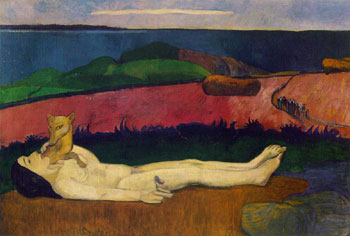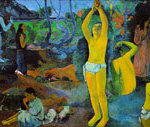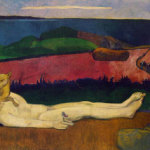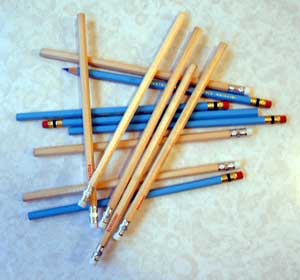You have an opportunity to win a Luxury Cruise to Tahiti aboard the six star M/S Paul Gauguin Radisson. You have until May 9 to fill out your form (available in the lobby of the MFA) and drop it in the adjacent plexiglass box. You must be over 18 years of age to win. You must be present at the MFA’s Memorial Day Open House in order to collect the grand prize. If you are chosen, you and your companion of choice will be treated to a seven-day tour of the waters and sights of Polynesia courtesy of the MFA, Fleet, CBS4, and the Radisson Seven Seas Cruises. Cruisecritic.com assures us, “If you’ve never been to French Polynesia, this spiffy, little liner is the way to go.” In the boutique (South Seas black pearl jewelry is a big seller) you can purchase a trove of Paul Gauguin-themed logo wear. I wonder if they sell designer condoms in Gauguin’s signature nipple-lavender, perverse- fox- orange, shady green, and voodoo- blue (don’t forget to ignore the legal age of your companion). Guest lecturers provide more cerebral stimulation by offering talks on the local customs, history, and attractions. When you venture into island life, Davidtours.com lets us know that the Tahitians are “renowned for their health, physical beauty, and spiritual serenity.” Welcome to Gauguin’s world.
If you are not the lucky winner, you can do a drive through of the Tahiti experience, if you drop by the MFA before June 21. Boston offers the only U.S. location for the Gauguin/Tahiti exhibition. Fill out your cruise form first. Then take the escalator up to the second floor. The layout for the show is a work of art in itself, from the canary orange (not perverse-fox-orange) walls that escort you into the first gallery, to the cayenne pepper accent walls, to the brooding charcoal gray walls that showcase the painting designated as Gauguin’s masterpiece (bigger is not always better!). We have entered our Xanadu, the tastefully done Tahiti pavilion. Gauguin is our Kubla Khan, the demon-lover. Over there is the original south sea-esque signboard provoking us with the title from Gauguin’s overworked masterpiece “Where do we come from? What are we? Where are we going?” Not that we are really supposed to think about it, but these are certainly relevant questions. Behind this elaborate signboard is the remarkably designed installation of enigmatic carved objects primarily from the Marquesas Islands ingeniously displayed in a raised bed of smooth gray rocks.
The standout painting in this room is Gauguin’s 1890-1891 "Loss of Virginity"; its title should have been the title for the show. The stiff naked body of the vanquished young woman is laid out parallel to our gaze. Wedged between her breast and mouth is the telltale fox. On the adjacent wall are a series of framed black and white photographs taken in and around Tahiti in the late 1800’s. They represent the point of view of a typical French colonial tourist. There is a very sad image by Paul-Emile Miot titled "The Royal Family of Vahi-Tahou" from the Marquesas, photographed on Board the French Frigate Astree. The group of four seated adults are huddled like refugees on the deck of the ship. In the middle are two women, naked from the waist up. Their expressions betray their desolation and despair. One would think that these documents would demand a context, an explanation. But we are given very little. We are told that by the time Gauguin arrived in Papeete, most traces of the ancient culture were gone and that it was, for Gauguin, a ‘cruel disappointment’. This would have been the time to help us understand a bit more about why the islanders were huddled on the Astree and why the traditional lifestyle and religious practices disappeared. We get a couple of sentences. We should have at least been informed about a few basic historical events. A bit of background text would have been helpful so we could have gained some insight into the evolution of myth of Tahiti as the exotic and erotic Other of the western imagination. The 1767 discovery of the island by Captain Samuel Wallis is central to the story-- the islander’s rocks were no match for English cannons. So are the circumstances surrounding the 1769 accounts of amorous encounters between the crew of Louis-Antoine de Bougainville’s two ships and the ‘nymphs’ of Tahiti. So is the fact that in 1769, the population of Tahiti was estimated at about 35,000. By the time Gauguin experienced feelings of cruel disappointment, European diseases had wiped out two thirds of the population.
I don’t think it’s a big secret that this highly ambitious blockbuster show is not really about Gauguin’s artistic project in Tahiti. These artifacts are assembled together to tell another kind of story that has much more to do with the politics of institutional economics. Gauguin’s story is glossed over. Maybe that’s a good thing. The more you read his notes and letters and dealings with other human beings, the more you wish you hadn’t. There is a reason why the young women in his paintings don’t face him directly. There is a reason why their bodies are stiff, their arms drawn inward, their eyes averted. There is a reason why he portrays himself as the orange fox and why there are roaring undercurrents of misogyny and racism. His obsession with rape plays over and over and over again with many guises.
The accompanying text cards proclaim that his color remains radiant to the end, though this is clearly not the case. It is evident that he loses his conviction after his return from the less- than -victorious trip to Paris. His color muddies, his tonal scale drops to mid and dark grays, and his forms begin to lose clarity. Gauguin quits using that pretty light pink, virtually phases out the saturated reds, develops a taste for shadowy blues, and leans heavily on his trademark orange. He never let go of his need to administer some touch of redemption-white. His strangely joyless images could use more than a small dose.
I watched the tour guides do their thing. They pointed out the clichéd brilliant and exotic color as they guided us from room to room. I wish they were garbed in appropriate period costume, the way Gauguin dressed up his ‘subjects’. The men could wear white loincloths and the women could go braless. Maybe all of the visitors could join in. We could pretend we were all winners of the contest and follow in Gauguin’s footsteps. Maybe then we could gain some insight into this perverse cultural project that seems not to have learned any lessons at all since the Captain Wallis’s H.M.S. Dolphin first dropped anchor in the South Seas over two hundred years ago.
- Where do we come from? What are we? Where are we going? 1897
- The Loss of Virginity, 1890-1891
Links:
Gauguin Tahiti at MFA, Boston
"Gauguin Tahiti" is on view through June 20, 2004 at the Museum of Fine Arts, Boston.
All images are courtesy of the Museum of Fine Arts, Boston.
Color, light, and finding patterns in patterns are of particular interest to Lou Larson.





